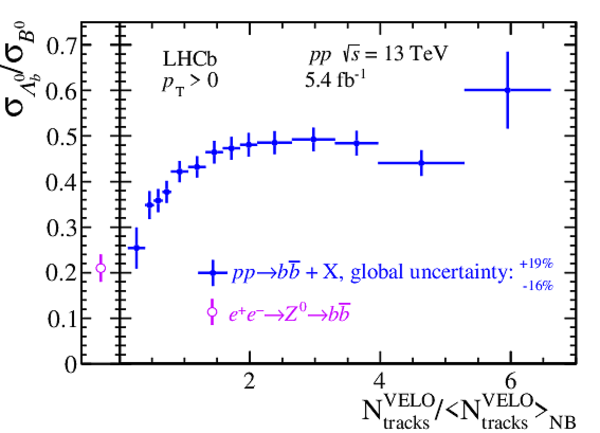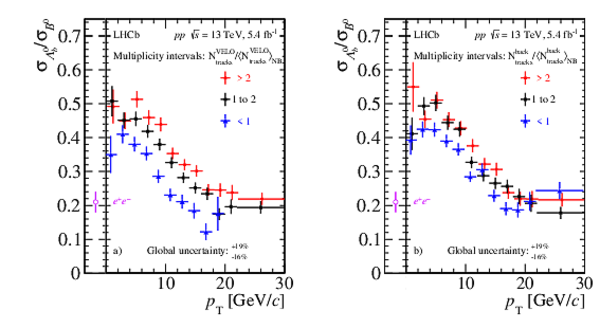Enhanced Production of Λb0 Baryons in High-Multiplicity pp Collisions at s=13 TeV
[to restricted-access page]Information
LHCb-PAPER-2023-027
CERN-EP-2023-208
arXiv:2310.12278 [PDF]
(Submitted on 18 Oct 2023)
Phys. Rev. Lett. 132 (2024) 081901
Inspire 2712864
Tools
Abstract
The production rate of $\Lambda_{b}^{0}$ baryons relative to $B^{0}$ mesons in $pp$ collisions at a center-of-mass energy $\sqrt{s} = 13$ TeV is measured by the LHCb experiment. The ratio of $\Lambda_{b}^{0}$ to $B^{0}$ production cross-sections shows a significant dependence on both the transverse momentum and the measured charged-particle multiplicity. At low multiplicity, the ratio measured at LHCb is consistent with the value measured in $e^{+}e^{-}$ collisions, and increases by a factor of $\sim2$ with increasing multiplicity. At relatively low transverse momentum, the ratio of $\Lambda_{b}^{0}$ to $B^{0}$ cross-sections is higher than what is measured in $e^{+}e^{-}$ collisions, but converges with the $e^{+}e^{-}$ ratio as the momentum increases. These results imply that the evolution of heavy $b$ quarks into final-state hadrons is influenced by the density of the hadronic environment produced in the collision. Comparisons with several models and implications for the mechanisms enforcing quark confinement are discussed.
Figures and captions
|
Invariant mass spectra in the transverse momentum interval $10< p_{\mathrm{T}} <12 \text{ Ge V /}c $ for the (a) $ { J \mskip -3mu/\mskip -2mu\psi } p K^{-}$ and (b) $ { J \mskip -3mu/\mskip -2mu\psi } \pi^{-} K^{+}$ final states, integrated over multiplicity. Fit projections including signal and background components are shown. |
Fig1.pdf [69 KiB] HiDef png [311 KiB] Thumbnail [223 KiB] *.C file |

|
|
Ratio of $\Lambda ^0_ b $ to $ B ^0 $ production cross-sections as a function of $ p_{\mathrm{T}} $ (blue circles). The error bars represent the quadrature sum of the statistical and systematic uncertainties and the boxes depict the global uncertainties due to branching fractions. The data are compared to previous $pp$ measurements using semileptonic decays (gray circles) [31], and data from $p$Pb collisions (squares) [57]. Calculations from a statistical hadronization model (SHM) [58], and the PYTHIA8 [42] and EPOS4HQ [60] event generators are also shown. |
Fig2.pdf [23 KiB] HiDef png [626 KiB] Thumbnail [410 KiB] *.C file |

|
|
Ratio of $\Lambda ^0_ b $ to $ B ^0 $ cross-sections as a function of the total track multiplicity measured in the VELO detector (blue). The purple point indicates the value measured in $e^{+}e^{-}$ collisions at LEP [61]. |
Fig3.pdf [16 KiB] HiDef png [179 KiB] Thumbnail [158 KiB] *.C file |

|
|
Ratio of $\Lambda ^0_ b $ to $ B ^0 $ cross-sections as a function of $ p_{\mathrm{T}} $, in bins of a) the total multiplicity measured in the VELO detector and b) the backwards track multiplicity. The purple point shows the value measured in $e^{+}e^{-}\rightarrow Z ^{0}\rightarrow b\bar{b}$ reactions at LEP [61]. |
Fig4.pdf [21 KiB] HiDef png [228 KiB] Thumbnail [213 KiB] *.C file |

|
|
Animated gif made out of all figures. |
PAPER-2023-027.gif Thumbnail |

|
Supplementary Material [file]
| Supplementary material full pdf |
supple[..].pdf [138 KiB] |

|
Created on 27 April 2024.
